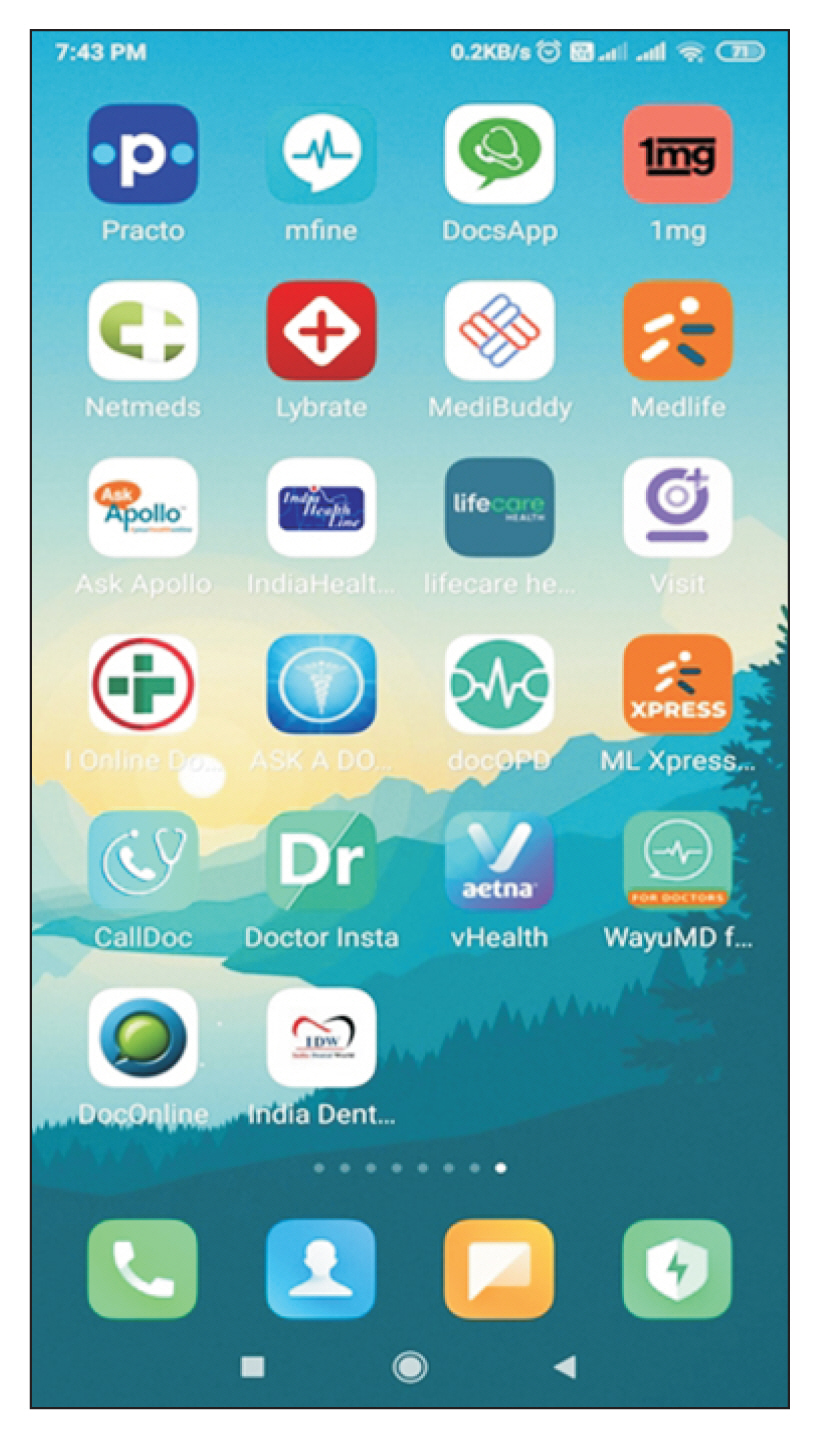Doctor Consultation through Mobile Applications in India: An Overview, Challenges and the Way Forward
- Affiliations
-
- 0Department of Community and Family Medicine, All India Institute of Medical Sciences, Patna,
- KMID: 2501340
- DOI: http://doi.org/10.4258/hir.2020.26.2.153
Abstract
Objectives To layout mHealth (mobile health) applications operating in India with the facility of either online doctor consultation or offline doctor appointment booking.
Methods A cross-sectional, observational and web-based study was conducted. We searched the Google Play Store with the search strategy “health apps in India”. In the results, 250 applications (apps) appeared. Out of 250 apps, finally, 22 apps were found to be providing online doctor consultation and/or doctor appointment booking-related services.
Results Among the selected mHealth apps operating in India and providing doctor consultation-related services online/offline, Practo, mfine, DocsApp, 1mg, Netmeds, Lybrate, MediBuddy, and Medlife were found to be the eight most popular ones with over a million downloads and on average four-plus user rating out of five. Practo, mfine, and Lybrate offer doctor consultation through chat, audio, and video calling. Netmeds and DocsApp offer doctor consultation through both chat and audio call. 1mg offers free chat consultation, while MediBuddy and Medlife offer audio call consultation only. Considering booking doctor appointments for offline consultation, Practo, mfine, 1mg, and Lybrate only offer this facility among the eight most popular selected mHealth apps.
Conclusions mHealth apps providing doctor consultation are gaining popularity in India, and they have enormous potential in the country. The government should make enabling policies to facilitate and popularise mHealth apps.
Keyword
Figure
Cited by 1 articles
-
Modification of Case-Based Reasoning Similarity Formula to Enhance the Performance of Smart System in Handling the Complaints of
in vitro Fertilization Program Patients
Paminto Agung Christianto, Eko Sediyono, Irwan Sembiring
Healthc Inform Res. 2022;28(3):267-275. doi: 10.4258/hir.2022.28.3.267.
Reference
-
References
1. World Health Organization. mHealth: New horizons for health through mobile technologies: second global survey on eHealth [Internet]. Geneva, Switzerland: World Health Organization;2011. [cited at 2020 Apr 1]. Available from: https://www.who.int/goe/publications/goe_mhealth_web.pdf.2. Tomlinson M, Rotheram-Borus MJ, Swartz L, Tsai AC. Scaling up mHealth: where is the evidence? PLoS Med. 2013; 10(2):e1001382.
Article3. International Telecommunication Union. Measuring the Information Society Report 2018 [Internet]. Geneva, Switzerland: International Telecommunication Union;2018. [cited at 2020 Apr 1]. Available from: https://www.itu.int/en/ITU-D/Statistics/Pages/publications/misr2018.aspx.4. Telecom Regulatory Authority of India. Wireless data services in India: an analytical report [Internet]. New Delhi, India: Government of India;2018. [cited at 2020 Apr 1]. Available from: https://main.trai.gov.in/sites/default/files/Wireless_Data_Service_Report_21082019_0.pdf.5. Kashgary A, Alsolaimani R, Mosli M, Faraj S. The role of mobile devices in doctor-patient communication: a systematic review and meta-analysis. J Telemed Telecare. 2017; 23(8):693–700.
Article6. Hsieh CH, Tsai HH, Yin JW, Chen CY, Yang JC, Jeng SF. Teleconsultation with the mobile camera-phone in digital soft-tissue injury: a feasibility study. Plast Reconstr Surg. 2004; 114(7):1776–82.
Article7. Mitchell M, Lesh N, Cranmer H, Fraser H, Haivas I, Wolf K. Improving care–improving access: the use of electronic decision support with AIDS patients in South Africa. Int J Healthc Technol Manag. 2009; 10(3):156–68.8. Garets D, Davis M. Electronic medical records vs. electronic health records: yes, there is a difference [Internet]. Chicago (IL): HIMSS Analytics;2006. [cited at 2020 Apr 1]. Available from: https://www.tehandassociates.com/wp-content/uploads/2017/03/WP_EMR_EHR.pdf.9. Patrick K, Griswold WG, Raab F, Intille SS. Health and the mobile phone. Am J Prev Med. 2008; 35(2):177–81.
Article10. Martins HM, Jones MR. What’s so different about mobile information communication technologies (MICTs) for clinical work practices? A review of selected pilot studies. Health Inform J. 2005; 11(2):123–34.11. Iribarren SJ, Cato K, Falzon L, Stone PW. What is the economic evidence for mHealth? A systematic review of economic evaluations of mHealth solutions. PLoS One. 2017; 12(2):e0170581.
Article12. de la Torre-Diez I, Lopez-Coronado M, Vaca C, Aguado JS, de Castro C. Cost-utility and cost-effectiveness studies of telemedicine, electronic, and mobile health systems in the literature: a systematic review. Telemed J E Health. 2015; 21(2):81–5.13. Ivatury G, Moore J, Bloch A. A doctor in your pocket: health hotlines in developing countries. Innovations. 2009; 4(1):119–53.
Article14. Ministry of Health & Family Welfare, National Health Systems Resource Centre. National Health Accounts-Estimates for India-2015–16 [Internet]. New Delhi, India: Government of India;2018. [cited at 2020 Apr 1]. Available from: http://nhsrcindia.org/updates/national-health-accounts-estimates-india-2015-16.15. Ahluwalia IJ. Challenges of urbanisation in India. Besley T, editor. Contemporary issues in development economics. London: Palgrave Macmillan;2016. p. 163–77.
Article16. Ministry of Statistics and Programme Implementation. India in figures 2018 [Internet]. New Delhi, India: Government of India;2018. [cited at 2020 Apr 1]. Available from: http://mospi.nic.in/sites/default/files/publication_reports/India_in_figures-2018_rev.pdf.17. Barve SS, Joshi S. A literature review of measurement of health literacy in India. Indian J Public Health Res Dev. 2019; 10(5):724–9.
Article18. Johri M, Subramanian SV, Kone GK, Dudeja S, Chandra D, Minoyan N, et al. Maternal health literacy is associated with early childhood nutritional status in India. J Nutr. 2016; 146(7):1402–10.
Article19. Ogorchukwu JM, Sekaran VC, Nair S, Ashok L. Mental health literacy among late adolescents in South India: what they know and what attitudes drive them. Indian J Psychol Med. 2016; 38(3):234–41.
Article20. Ministry of Home Affairs. Post Enumeration Survey Reports 2011 [Internet]. New Delhi, India: Government of India;2011. [cited at 2020 Apr 1]. Available from: http://censusindia.gov.in/2011Census/pes/pes_highlights.html.21. World Health Organization. World health statistics 2016: monitoring health for the SDGs, sustainable development goals [Internet]. Geneva, Switzerland: World Health Organization;2016. [cited at 2020 Apr 1]. Available from: https://apps.who.int/iris/handle/10665/206498.22. Muralidharan K, Chaudhury N, Hammer J, Kremer M, Rogers FH. Is there a doctor in the house? Medical worker absence in India [Internet]. Cambridge (MA): Harvard University;2011. [cited at 2020 Apr 1]. Available from: http://www.hrhresourcecenter.org/node/3964.
- Full Text Links
- Actions
-
Cited
- CITED
-
- Close
- Share
- Similar articles
-
- The Perception of Laymen and Experts Toward Mobile Applications for Self-monitoring of Diet Based on in-depth Interviews and Focus Group Interviews
- JXTA: A Technology Facilitating Mobile P2P Health Management System
- Challenges and recommendations in the implementation of audiovisual telemedicine communication: a systematic review
- Qualitative assessment of atopic dermatitis-related mobile applications in Korea
- Valuable mobile applications for medical practice



